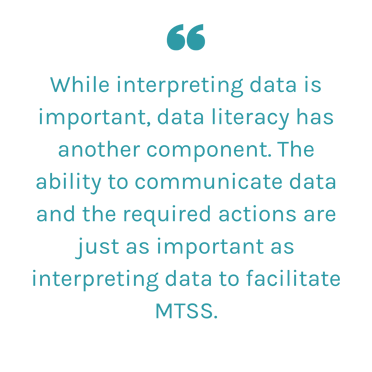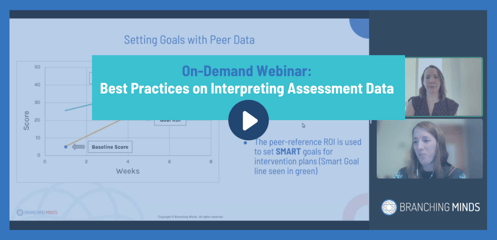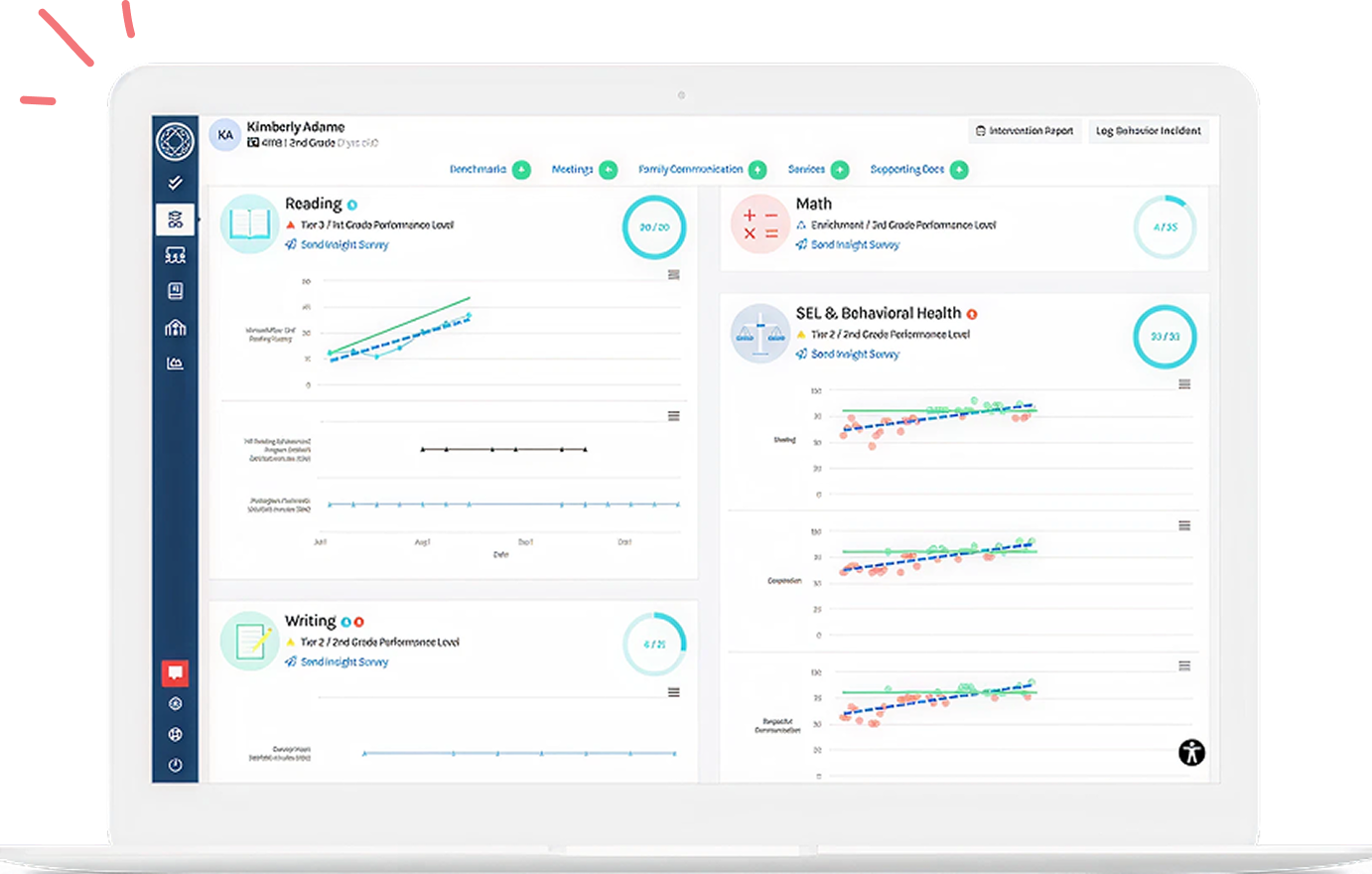Within an MTSS (Multi-Tiered System of Supports) framework, educators are asked to collect and understand different data to drive their decision-making process. A successful MTSS implementation will rely on a myriad of data, from screening and progress monitoring assessment data to tier movement and benchmark growth.
Key points of this article:
|
Data is a part of our everyday lives, both in and out of the classroom. Data literate educators can collect meaningful data and integrate data into their decision-making more seamlessly.
In their 2015 report, Building a conceptual framework for data literacy, Ellen Mandinach, and Edith Gummer define data literacy as "the ability to transform information into actionable instructional knowledge and practices by collecting, analyzing, and interpreting all types of data (assessment, school climate, behavioral, snapshot, longitudinal, moment-to-moment, etc.) to help determine instructional steps."
If that seems easier said than done, let's unpack these elements to understand what they mean and how they can apply to our MTSS practice.
How To Select Data To Support MTSS
Educators use various data points to support students, such as:
- Progress monitoring assessment scores
- Screening scores
- Attendance
- Behavior
- EWI indicators
With so many options, it can be difficult to break through the noise to get to the root of the data that will be the most meaningful.
The NCSI (National Center for Systemic Improvement) calls out some key questions that are helpful to consider when determining what data to collect:
- What data has been collected in the past?
- What do we need to know to provide instruction and services in the fall?
- What do we need to know to identify regression based upon change of instruction from spring and summer? (In other words, what data do we need to identify regression or progress in student learning throughout the year?)
- What do our staff, families, and students need to know? What do they want to know?
The data educators use to make these data-driven decisions can often be found in a variety of systems, such as:
- Student Information System (SIS): houses specific information related to individual students
- Assessment Vendor Platforms: Screening and progress monitoring assessment
- Additional data found in EL programs or IEP Platforms.
Collecting the data needed to make these decisions can also be tedious. This is especially true when districts lack a streamlined system to collect data. Data collection can be as simple as entering information into an Excel spreadsheet, but that doesn’t mean educators always know how to quickly and efficiently access the information they need.
A 2020 survey conducted by the Harris Poll revealed that only 31% of teachers strongly agreed that they had access to the student data they needed to provide relevant instruction (e.g., student test scores and reading-level data).
These barriers can inhibit educators from taking the first steps towards making data-driven decisions within their MTSS framework.
Understanding Data Drives the MTSS Decision-Making Process
Data analysis goes beyond just reading the numbers. To understand data, we must understand the context of the data and what the expectations are.
Let’s take a look at Johnny, a 4th-grade student who has recently been identified as needing Tier 2 support in math.
According to his universal screening data, Johnny struggles with understanding equations and is given an intervention plan to target this deficit skill. However, additional data shows that Johnny is also a student that needs English Language Learning support. Even further diagnostic data shows that Johnny understands the mathematical concepts of equations, however, he struggles to comprehend the language component of word problems used in the universal screening assessments.
This would lead to a different intervention plan than what was previously determined, thanks to further data investigation and analysis.
These situations are common occurrences for educators. Proper MTSS data use means that educators are able to interpret different forms of data. This analysis allows educators to accurately understand trends and patterns, and create targeted approaches to support a student.
Sound familiar? This cycle drives the data-driven decision-making process, which is the foundation of MTSS.
➡️ On-Demand Webinar: Using Screening Data to Tier Students for RTI/MTSS
How To Communicate Data and Results
While interpreting data is important, data literacy has another component. The ability to communicate data and the required actions are just as important as interpreting data to facilitate MTSS.
 Let’s break down some key components of why communicating data is important:
Let’s break down some key components of why communicating data is important:
- Educators must know how to modify their instruction or intervention to support individualized learning fueled by students' data.
- Data will need to be shared with all stakeholders—without bias and misinterpretation.
To put it in perspective, think of all of the time and effort that would go into understanding how to support Johnny.
We need to collect the data and analyze it. But what if we aren’t directly facilitating the next actions? Imagine if we shared the data results with collaborators without properly
communicating. This could lead to the wrong next steps due to a misunderstanding of the data. Similar to the example we looked at before.
➡️ Related Resource: Communication Planning for MTSS
Make Sure Everyone Involved Understands the Data
Often, data needs to be shared with administrators, reported to the state, and sent out to families.
Knowing how to properly communicate data is key to ensuring that everyone involved understands the results of the data—even if not everyone reading those results can analyze the data themselves.

Keep in mind, when sharing data it’s important to:
- Tailor the sharing method to suit the audience
- Include context to help the audience understand results
- Not compromise the validity of information
To do this well, educators should:
- Understand their audience
- Have a method available to communicate that is appropriate for the context
A report shared out to families would not look the same as a dashboard used by a school administrator. Programs such as Branching Minds help present data back in an easily digestible format suited to the proper audience, be it administrators or families. Check out this article on How To Speak With Families and Communities About MTSS.
How To Build a Culture of Data Literacy
So how can we begin to build a culture of data literacy?
TIP #1: Provide educators with the tools to collect data accurately, securely, and with ease.
If educators are expected to make decisions using data, they'll need access to tools to collect that data in the first place.
A 2014 research project, Teachers Know Best, revealed that the average teacher may spend up to 7.5 hours per week on instructional planning during school hours and up to 9 hours per week outside of school hours.
Educators have limited time to accomplish all of the tasks they have on a given day. They have to spend too much time determining what data to collect, collecting that data, making sure the data collected is valid, and doing it all manually. When data collection is laborious and manual, it reduces the appeal for regular data collection.
Without a streamlined system of collection, data analysis can inhibit the MTSS process rather than facilitate it. It’s important that schools have a quick and efficient method of collecting data, so educators have more time to focus on decisions based on the data.
TIP #2: Ensure that educators have easy access to all of the data they need in order to make decisions.
Educators need easy access to the data required to make decisions and to modify their instruction to support students.
Even more so, educators need access to tools that centralize all of the different data they use regularly. If simply accessing the data needed is a cumbersome process, becoming a data literate and data-driven educator becomes an uphill battle.
TIP #3: Provide educators with continuous training and resources to build (and maintain!) their data literacy skills.
Data literacy is a skill that takes time to develop. Educators need access to professional development that supports their journey to become more data literate.
This does not mean that educators must be trained in advanced data analytics or statistics. Educators should understand enough about data to begin incorporating them into their instructional planning and their decision-making process.

As with most skills, this development and training should be done on an ongoing and continuous basis. Educators should be given the opportunity to reflect on the skills they've developed and how they use data in their work, and then continue to build upon those skills.
This is not something that can be accomplished with a one-time professional development session. Rather, educators need continuous opportunities to obtain and foster these skills.
TIP #4: Integrate data into the day-to-day teaching and support experience.
Incorporating data into the day-to-day for educators involves a lot of adjustments—but the reward is a data-driven culture centered around providing the best support for all students.
When educators begin to use data regularly to drive their work, it becomes a core part of their job. By reducing the novelty of a data-driven workflow, data-based decision-making becomes the norm. As one of the central components of MTSS, a strong data culture is essential in understanding and meeting the needs of all students.
TIP #5: Keep data organized, accessible, and streamlined for educators and administrators.
Keeping data organized and streamlined allows educators the time to incorporate data into their lesson planning, their intervention work, and teaching. Data is everywhere, and the more we actively work with it, the more we can understand how to work with it.
All this data does require some security. Districts will need to ensure that all data is stored and managed securely, as well as protocols in place to provide additional protection. An MTSS software program can help provide that layer of data protection while facilitating the day-to-day needs of a data-driven MTSS process.
Teaching, especially teaching within an MTSS framework, is more collaborative today than ever before. Clear and accessible data are essential in aiding all stakeholders in making the best decisions possible in supporting a student.
But to get to this level of collaboration, all stakeholders need to understand how to access data, how to utilize data, and how to create actionable steps from that data.
This means building a culture of data literacy that reflects the collaborative structure of the MTSS process itself.
Check out this on-demand webinar ➡️
Best Practices on Interpreting Assessment Data
References:
Bill & Melinda Gates Foundation; Web site: http://www.gatesfoundation.org. (2015, May 31). Teachers know best: Making data work for teachers and students. Bill & Melinda Gates Foundation.
Gummer, E.S. & Mandinach, E.B. (2015). Building a conceptual framework for data literacy. Teachers College Record, 117 (4), 1-12.
Mann, B. (2021, October 28). 2020 national teacher poll. Data Quality Campaign. Retrieved from https://dataqualitycampaign.org/resource/2020-teacher-poll/
NCSI: Considerations for the fall - applying the essential ... National Center for Systemic Improvement. (2020, July). Retrieved from https://ncsi.wested.org/wp-content/uploads/2020/07/NCSI-Considerations_for_the_Fall-Applying_the_Essential_Elements_of_Data_Literacy_to_Respond_to_Student_and_System_Needs.pdf
![[Guest Author] Kanisha Vaughn-avatar](https://www.branchingminds.com/hs-fs/hubfs/Team/Round%20cropped%20headshots/correct%20Round%20headshots%20(64).png?width=82&height=82&name=correct%20Round%20headshots%20(64).png)
About the author
[Guest Author] Kanisha Vaughn

Your MTSS Transformation Starts Here
Enhance your MTSS process. Book a Branching Minds demo today.
















.png?width=716&height=522&name=The%20Power%20of%20Good%20Data%20(blog).png)
.png?width=716&height=522&name=Qualitative%20data%20MTSS%20(preview).png)
